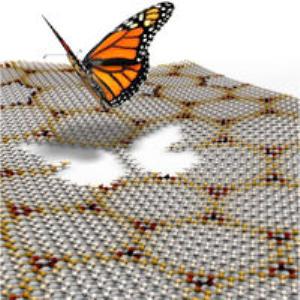May 16 2013
Two research teams at the National High Magnetic Field Laboratory (MagLab) broke through a nearly 40-year barrier recently when they observed a never-before-seen energy pattern.
 An artistic illustration of a butterfly departing from a graphene moiré pattern formed on the top of an atomically thin boron nitride substrate. Electron energy in such graphene moiré structures exhibit butterfly-like self-recursive fractal quantum spectrum. Illustration by James Hedberg for Columbia University.
An artistic illustration of a butterfly departing from a graphene moiré pattern formed on the top of an atomically thin boron nitride substrate. Electron energy in such graphene moiré structures exhibit butterfly-like self-recursive fractal quantum spectrum. Illustration by James Hedberg for Columbia University.
The butterfly-shaped pattern was first theorized by physicist Douglas Hofstadter in 1976, but it took the tools and technology now available at the MagLab to prove its existence.
"The observation of the 'Hofstadter butterfly' marks a real landmark in condensed matter physics and high magnetic field research," said Greg Boebinger, director of the MagLab. "It opens a new experimental direction in materials research."
This groundbreaking research demanded the ability to measure samples of materials at very low temperatures and very high magnetic fields, up to 35 tesla. Both of those conditions are available at the MagLab, making it an international destination for scientific exploration.
The unique periodic structure used to observe the butterfly pattern was composed of boron nitride (BN) and graphene. Graphene is a Nobel Prize-winning material that holds tremendous promise in revolutionizing computers, batteries, cell phones, televisions and even airplanes. A one-atom thick, honeycomb array of carbon atoms, graphene is virtually see-through, yet 300 times stronger than steel and 1,000 times more conducting than silicon.
"This is about a puzzle that has been solved," said Eric Palm, deputy director at the MagLab. "It is really about scientific curiosity. It is an exciting confirmation of a theory that was made years ago."
MagLab physicist Nicholas Bonesteel agreed, adding "The Hofstadter butterfly is a beautiful fractal energy pattern that has intrigued physicists for decades. Seeing clear experimental evidence for it is a real breakthrough."
One research team was led by Columbia University's Philip Kim and included researchers from City University of New York, the University of Central Florida, Tohoku University and the National Institute for Materials Science in Japan. The team's work will be published today in the Advanced Online Publication of the journal Nature. Similar results were discovered at the MagLab by a group led by Pablo Jarillo-Herrero and Raymond Ashoori at MIT, as well as scientists from Tohoku University and the National Institute for Materials Science in Japan. Their work is expected to be published soon.